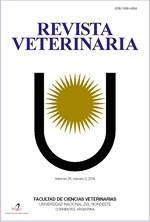Echographycal and hematological alterations in dogs with visceral leishmaniasis
DOI:
https://doi.org/10.30972/vet.3114632Keywords:
Canines, visceral leishmaniasis, hematology, abdominal echography, echogenicityAbstract
Canine visceral leishmaniasis is a multisystemic disease with clinical signs such as splenomegaly, hepatomegaly, lymphadenopathy and glomerulonephritis. The presentation of anemia associated with hyperproteinemia is frequent. Ultrasound can reveal morphological and structural abnormalities of the abdominal organs. The objectives of this work were to evaluate the visible lesions of the abdominal organs by means of ultrasound, and to establish relationships with laboratory analysis. The parasite was detected by indirect parasitological and serological diagnoses. The affected abdominal organs were evaluated by ultrasound (shape, size, structure and echogenicity). The cortex/medulla ratio was explored in the kidneys. At the laboratory, hemogram and blood biochemistry of each patient were investigated. The clinical staging of the dogs was 50% for moderate stage, 40% for severe, and 10% for very severe. The main alterations were hepatomegaly (8 patients), splenomegaly (1 case) and increased echogenicity of the renal cortex with decreased corticomedular definition and lymphadenomegaly (5 animals). Around 90% of the animals revealed anemia accompanied by hyperproteinemia. It is concluded that the use of ultrasound in conjunction with blood tests can help to establish the severity of abdominal organ injuries in dogs with leishmaniasis.
Downloads
References
Cairó VJ, Font GJ. 1991. Leishmaniosis canina. Aspectos clínicos. Clín Vet Peq Anim 11: 73-80.
Carvalho CF. 2014. Ultrassonografia em pequenos animais, 2da. ed., Edit. Gen, Sao Paulo, 468 p.
Cordero CM, Rojo FA. 2002. Parasitología Veterinaria, Ed. McGraw-Hill Interamericana, Madrid, p. 652-665.
Gad B et al. 2008. Canine leishmaniosis: new concepts and insights on an expanding zoonosis, Trends in Parasit 24: 324-329.
Gómez N et al. 2011. Leishmaniosis visceral en caninos y felinos: actualización. Rev Vet Arg 28: 1-12.
Hernández LM. 2016. Estudio de la infección por Leishmania infantum en el perro: utilidad de las técnicas diagnósticas no invasivas y nuevas alternativas terapéuticas. Tesis doctoral, Univ. Complut. Facult. Veterin. Madrid, 291 p.
Koutinas AF et al. 1999. Clinical considerations on canine visceral leishmaniasis in Greece: a retrospective study of 158 cases (1989-1996). J Am Anim Hosp Assoc 35: 376-383.
Nelson RW, Couto G. 2010. Medicina interna de pequeños animales, 4th. ed., Edit. Elsevier, España, 1363 p.
Solano GL et al. 2009. Directions for the diagnosis, clinical staging, treatment and prevention of canine leishmaniosis. Vet Parasitol 165: 1-18.
Tosta SF et al. 2010. Aspectos clínicos da leishmaniose visceral canina no distrito de Monte Gordo, Camaçari (Brazil). Rev Baiana Saúde Públ 34: 783-795.
Downloads
Published
How to Cite
Issue
Section
License
Revista Veterinaria (Rev. Vet.) maintains a commitment to the policies of Open Access to scientific information, as it considers that both scientific publications as well as research investigations funded by public resources should circulate freely without restrictions. Revista Veterinaria (Rev. Vet.) ratifies the Open Access model in which scientific publications are made freely available at no cost online.










.jpg)
.jpg)



